My grandfather, George Lines, was an Army reservist, so was called up on the outbreak of war. He was in the Royal Engineers. From his Medal Record he was in the 126th Field Company, although from his London Gazette entry he was attached to the 497th (Kent) Field Company.
Royal Engineers Volunteers
I don’t have any direct record of his time in the Royal Engineers Volunteers, but his application for his Commission states that he served in the Electrical Engineers, of the Royal Engineers Volunteers from 1904 to 1907 (when he would have been aged 16 to 19). This would presumably have been the Volunteer Force, and possibly the London Electrical Engineers.
Enlistment
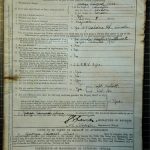 He was enlisted – as Private , into the Royal Fusiliers, on 15th September 1914. This document also shows that he did a 4 Year Apprenticeship at Clayton & Shuttleworth in Lincoln, which ended in December 1911, and that he had been in the “E.E.R.E.V.” (I think this is the Electrical Engineers, Royal Engineers, Volunteers) for 3 years.
He was enlisted – as Private , into the Royal Fusiliers, on 15th September 1914. This document also shows that he did a 4 Year Apprenticeship at Clayton & Shuttleworth in Lincoln, which ended in December 1911, and that he had been in the “E.E.R.E.V.” (I think this is the Electrical Engineers, Royal Engineers, Volunteers) for 3 years.
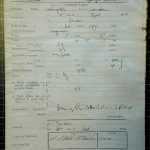 Here is his medical form on enlistment (amended on 8th December 1914 to show “discharge on receiving commission”
Here is his medical form on enlistment (amended on 8th December 1914 to show “discharge on receiving commission”
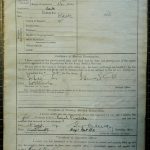
His Description on Enlistment shows his Religious Denomination as “Church of England”, the other choices being “Presbyterian”, “Wesleyan”,”Baptist or Congregationalist”,”Other Protestants (Denomination to be stated)”, “Roman Catholic” or “Jewish”. There was no “Other” or “None” option.
Commission
He applied for a temporary commission in the Army on the 1st November 1914, at which time he was already serving in the 1st Battalion Fusiliers since 18th September 1914. This form (page 1) also shows that he served in the Electrical Engineers, of the Royal Engineers Volunteers from 1904 to 1907 as above.
 He was signed off as fit at Hounslow on 1st November 1914. His medical certificate shows his height at 5’7″ and his weight at 140lbs
He was signed off as fit at Hounslow on 1st November 1914. His medical certificate shows his height at 5’7″ and his weight at 140lbs
He was appointed a temporary Second Lieutenant on 8th December 1914, Which generated a whole flurry of paperwork, showing his regimental number for the 18th R. Batt Royal Fusiliers as 1750 on the Statement of Services.
Wounds
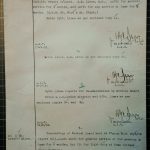
He was wounded at Armentières on 9th February 1916, with gunshot wounds to his right foot and right thigh, which rendered him unfit for general service for 3 months, and for any service at home for 2 months. and returned to service in August – by which time he was promoted to Lieutenant. Note that this document relates to the 126th Field Company.
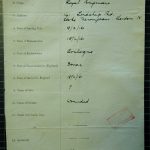
This document, dated 13th March 1916 shows that he traveled from Boulogne to Dover on the 18th of February.
The Medical Board on the 13th March 1916 found him unfit for service at home for 2 months.

On 17th March he was signed off until 12th May, with orders to report in writing ten days before the leave expired to be re-examined
 On 1st May he reports, as ordered, giving his address, so he can be re-examined.
On 1st May he reports, as ordered, giving his address, so he can be re-examined.
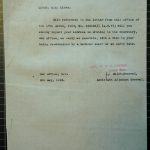 On the 8th May the war office write to him, asking for his address, so he can be re-examined (I wonder which address this was sent to ?_
On the 8th May the war office write to him, asking for his address, so he can be re-examined (I wonder which address this was sent to ?_
On 11th May the War Office write to him, and to the people who set up a medical board, telling them to arrange one.
 The Medical Board meets on 18th May, and finds his condition considerably improved, and that he is fit for light duty at home, with no route marches.
The Medical Board meets on 18th May, and finds his condition considerably improved, and that he is fit for light duty at home, with no route marches.
On 24th May he is ordered to report to Ripon for light duty. At this point he is a 2nd Lieutenant.
The Wartime Memories Project has a description of The Great War Hospitals
The Long Long Trail site has pages about The evacuation chain, describing the process he would have gone through, and Command Depots, such as Ripon, describing life there.
 On 26th June he writes from R.A.&R.E. Convalescent Depot, Ripon to the Secretary at the War Office asking if he is entitled to wound gratuity. The letter is signed G.E.Lines Lt. RE. so he has been promoted by now.
On 26th June he writes from R.A.&R.E. Convalescent Depot, Ripon to the Secretary at the War Office asking if he is entitled to wound gratuity. The letter is signed G.E.Lines Lt. RE. so he has been promoted by now.
On 11th July he is ordered to be re-examined to see if he is fit for general service.
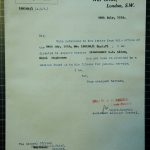 On 26th July the War Office write to ask if he is ready for general service yet.
On 26th July the War Office write to ask if he is ready for general service yet.
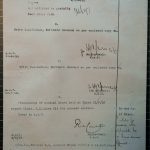 This sheet shows that the Medical Board held at Ripon on 31st July found him fit for general service, and on the 10th August he was ordered to Newark from Ripon.
This sheet shows that the Medical Board held at Ripon on 31st July found him fit for general service, and on the 10th August he was ordered to Newark from Ripon.
He was wounded 3 times in all – though I do not have the details for all of these injuries.
Medals
He was awarded the Military Cross for:
T./Lt. (A./Capt.) George Edward Lines, R.E., attd. 497th (Kent) Fd. Coy., R.E., T.F. • For great gallantry and determination dur- ing operations which led up to the establish- ment of our line across the Lys on night of 19/20th Oct. 1918. He personally super- vised the building of infantry bridges across the river under heavy fire, and it was due to his .example that the operation was car- ried to a successful issue.
The above text is from Supplement to The London Gazette 4-October-1919 page 12311
George Edward Lines Medal Card. Note that this shows his corps as 126th Company Royal Engineers, but his Medal citation shows that at the time of 19th/20th October 1918 he was attached (attd.) to the 497th Field Company. That also shows that he was an acting captain, so was probably second in command of the Company, with a Major in charge.
The back of the card shows that his forwarding address was Grove Farm, Box, Wilts.
Discharge
 He was discharged on on 4th April 1919. His discharge papers show that he was eligible for the rank of Captain on relinquishment.
He was discharged on on 4th April 1919. His discharge papers show that he was eligible for the rank of Captain on relinquishment.
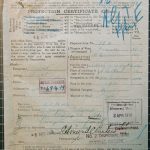
The Protection Certificate shows he was attached to the 497th Field Company when he was discharged, from Dispersal Area 10A and the Dispersal Unit was Crystal Palace. This link has more information on the demobilisation process.
Links
While he was recuperating from his wounds Grandpa spent some time in Bristol with the Stevens family and sung the part of The Mikado in the Gilbert and Sullivan operetta.
When still at Pickwick at a family Christmas party I encouraged my son Graham who wanted to be a journalist to ask Uncle Chief what he did in the war?
“He said he was an engineer and it was only because he had a good horse that he survived.They were crossing a ploughed field when they came under fire and he was badly injured but his horse got him out and he survived. By the time he recovered back home the war was almost over.
He had never spoken to his sons about this and Tim was amazed when I told him. I don’t know how this fits in with his war record.